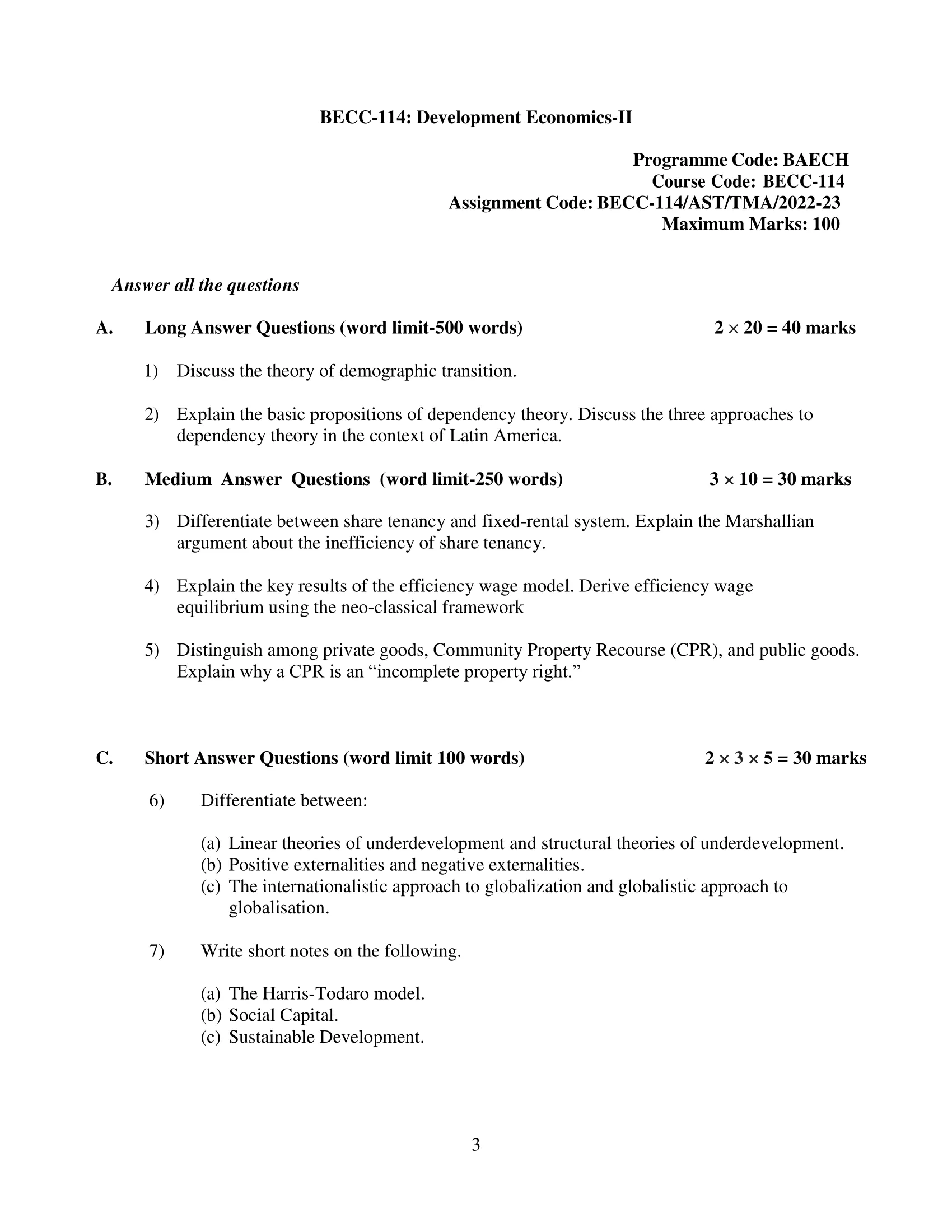Contents
- 1 A. Long Answer Questions (word limit-500 words)
- 2 1) Discuss the theory of demographic transition.
- 3 2) Explain the basic propositions of dependency theory. Discuss the three approaches to dependency theory in the context of Latin America.
- 4 B. Medium Answer Questions (word limit-250 words)
- 5 3) Differentiate between share tenancy and fixed-rental system. Explain the Marshallian argument about the inefficiency of share tenancy.
- 6 4) Explain the key results of the efficiency wage model. Derive efficiency wage equilibrium using the neo-classical framework.
- 7 5) Distinguish among private goods, Community Property Recourse (CPR), and public goods. Explain why a CPR is an “incomplete property right.”
- 8 C. Short Answer Questions (word limit 100 words)
- 9 6) Differentiate between:
- 10 (a) Linear theories of underdevelopment and structural theories of underdevelopment.
- 11 (b) Positive externalities and negative externalities.
- 12 (c) The internationalistic approach to globalization and globalistic approach to globalisation.
- 13 7) Write short notes on the following.
- 14 (a) The Harris-Todaro model.
- 15 (b) Social Capital.
- 16 (c) Sustainable Development.

| Title | BECC-114: IGNOU BAG Solved Assignment 2022-2023 |
| University | IGNOU |
| Degree | Bachelor Degree Programme |
| Course Code | BECC-114 |
| Course Name | Development Economics-II |
| Programme Name | Bachelor of Arts (General) |
| Programme Code | BAG |
| Total Marks | 100 |
| Year | 2022-2023 |
| Language | English |
| Assignment Code | BECC-114/AST/TMA/2022-23 |
| Last Date for Submission of Assignment: | For June Examination: 31st April For December Examination: 30th September |

A. Long Answer Questions (word limit-500 words)
1) Discuss the theory of demographic transition.
Ans: The theory of demographic transition is a model that explains how countries go through a series of changes in their birth and death rates as they develop from pre-industrial to industrialized economies. The theory was first proposed by Frank Notestein in 1945 and it has been widely used to explain population changes in various countries around the world.
The demographic transition theory is based on four stages, each of which is characterized by a different pattern of birth and death rates. The first stage is the pre-industrial stage, where both birth and death rates are high, leading to a relatively stable population size. In this stage, people have large families as a way to compensate for the high infant and child mortality rates.
The second stage is the transitional stage, where there is a decline in death rates due to improvements in healthcare, sanitation, and food production, but birth rates remain high. This leads to a rapid increase in population size as there are more births than deaths. This stage is usually accompanied by an increase in urbanization and education.
The third stage is the industrial stage, where birth rates start to decline due to social and economic changes that lead to a shift in attitudes towards family size. This includes greater access to family planning methods, higher education levels, and increased opportunities for women in the workforce. At the same time, death rates continue to decline, leading to a continued increase in population size, although at a slower rate than in the previous stage.
The fourth and final stage is the post-industrial stage, where both birth and death rates are low, leading to a relatively stable population size. In this stage, people have smaller families and there is a shift towards an aging population as life expectancies continue to increase.
The demographic transition theory has been criticized for being too simplistic and for failing to take into account the role of culture, politics, and economics in population change. However, it remains a useful model for understanding population trends and for guiding public policy on issues related to population growth, family planning, and healthcare.
2) Explain the basic propositions of dependency theory. Discuss the three approaches to dependency theory in the context of Latin America.
Ans: Dependency theory is a social and economic theory that emerged in the 1960s and 1970s as a critique of modernization theory, which viewed economic development as a linear process that could be achieved by adopting Western models of industrialization and capitalism. Dependency theory argues that economic development in the Global South is hindered by the unequal relationships between developed and developing countries.
The basic propositions of dependency theory are:
- Core-periphery relations: Dependency theory posits that the world economy is divided into a core of developed countries and a periphery of developing countries. The core countries are the dominant economic and political powers, while the periphery countries are dependent on the core for investment, technology, and market access.
- Unequal exchange: Dependency theory argues that the trade relations between core and periphery countries are characterized by unequal exchange, where the periphery exports low-value primary commodities and imports high-value manufactured goods from the core. This leads to a structural imbalance that perpetuates underdevelopment in the periphery.
- Underdevelopment: Dependency theory sees underdevelopment as a result of the historical and structural relations between core and periphery countries. The periphery is dependent on the core for investment and technology, which limits its ability to develop its own industries and diversify its economy.
In the context of Latin America, three approaches to dependency theory have emerged:
- The structuralist approach: This approach, developed by economists such as Raúl Prebisch, emphasizes the role of external factors, such as unequal trade relations and the international division of labor, in perpetuating underdevelopment in Latin America. Structuralists argue that the only way for Latin America to break free from dependency is to promote import substitution industrialization and to develop its own industries.
- The Marxist approach: This approach, developed by writers such as Andre Gunder Frank, emphasizes the role of internal factors, such as class relations and the concentration of wealth and power, in perpetuating underdevelopment in Latin America. Marxists argue that the only way to break free from dependency is to promote socialist revolution and to seize control of the means of production.
- The neo-dependency approach: This approach, developed in the 1980s and 1990s, emphasizes the role of both internal and external factors in perpetuating underdevelopment in Latin America. Neo-dependency theorists argue that the only way to break free from dependency is to promote democratic governance, social justice, and economic diversification.
B. Medium Answer Questions (word limit-250 words)
Ans: Share tenancy and fixed-rental system are two common systems for agricultural land leasing.
In a share tenancy system, the landowner provides the land and the tenant farmer provides labor, capital, and management. The crop is then shared between the landowner and the tenant farmer based on a predetermined ratio. In a fixed-rental system, the tenant farmer pays a fixed amount of rent to the landowner, regardless of the success or failure of the crop.
The Marshallian argument about the inefficiency of share tenancy is based on the assumption of risk aversion. According to Marshall, the tenant farmer may not have sufficient incentives to invest in the land and improve the crop yield because the benefits of such investments are shared with the landowner. The tenant farmer also faces a high level of risk in a share tenancy system because a poor crop yield reduces their share of the crop and income.
As a result, tenant farmers under a share tenancy system tend to underinvest in the land and the crop, leading to lower crop yields and inefficiency. In contrast, in a fixed-rental system, the tenant farmer bears the entire risk of crop failure and is motivated to maximize crop yields to ensure a profitable return on their investment. The fixed rental system thus provides greater incentives for tenant farmers to invest in the land and improve crop yields, resulting in more efficient outcomes.
Overall, while the share tenancy system may have some advantages in terms of risk-sharing and access to land for tenant farmers, it may also result in inefficient outcomes due to the problem of risk aversion and underinvestment. The fixed-rental system may provide greater incentives for tenant farmers to invest in the land and improve crop yields, but may also lead to greater financial risk for the tenant farmer.
4) Explain the key results of the efficiency wage model. Derive efficiency wage equilibrium using the neo-classical framework.
Ans: The efficiency wage model suggests that paying higher wages to workers can lead to increased productivity and profitability for firms, due to factors such as reduced worker turnover and increased worker effort. The key results of the efficiency wage model are as follows:
- Firms can profitably pay wages above the market-clearing level: By paying higher wages, firms can attract a higher quality pool of workers, reduce turnover and training costs, and motivate workers to work harder and be more productive. These benefits can offset the increased wage costs, allowing firms to earn higher profits.
- Unemployment can exist even in a competitive labor market: If firms pay higher wages than the market-clearing level, more workers may be willing to work for those firms, resulting in excess demand for those jobs and unemployment for workers who are unable to find work at those firms.
- Minimum wage laws can increase employment: If a minimum wage is set below the efficiency wage level, firms may choose to pay the minimum wage and hire more workers than they would otherwise. This can increase overall employment levels.
The neo-classical framework can be used to derive the efficiency wage equilibrium. The model assumes that workers are motivated by both the wage they receive and the utility they derive from leisure time. Firms seek to maximize profits by hiring workers and producing output, subject to a production function that depends on the amount of labor used.
In this framework, the efficiency wage equilibrium occurs when the wage is set at a level that maximizes the firm’s profits, subject to the condition that the workers’ utility from leisure time is equal to the opportunity cost of their labor (i.e. the wage they could earn elsewhere). This condition ensures that the firm is paying a wage that is high enough to motivate workers to work hard and be productive, but not so high that the firm’s profits are reduced by excessive labor costs.
At the efficiency wage equilibrium, the wage is higher than the market-clearing wage, which results in unemployment for workers who are unable to find jobs at firms paying the efficiency wage. However, the benefits of higher productivity and reduced turnover for firms can outweigh the costs of this unemployment, leading to higher profits overall.
5) Distinguish among private goods, Community Property Recourse (CPR), and public goods. Explain why a CPR is an “incomplete property right.”
Ans: Private goods, community property resources (CPRs), and public goods are different types of goods based on their characteristics and ownership.
Private goods are rivalrous and excludable. This means that the consumption of private goods by one individual prevents the consumption of the same good by another individual, and it is possible to exclude individuals who do not pay for the good from consuming it. Examples of private goods include food, clothing, and cars.
CPRs are goods that are non-excludable but rivalrous. This means that while consumption of CPRs by one individual does not prevent consumption by others, it is difficult or impossible to exclude individuals from using the good. Examples of CPRs include fisheries, forests, and groundwater.
Public goods are non-rivalrous and non-excludable. This means that the consumption of public goods by one individual does not reduce the ability of others to consume the good, and it is difficult or impossible to exclude individuals from using the good. Examples of public goods include national defense, clean air, and public parks.
A CPR is an “incomplete property right” because the property right is not well-defined and enforced. While CPRs are often owned by communities or shared by multiple individuals, there is no clear legal framework for defining and enforcing ownership rights or regulating use. This can lead to overuse or depletion of the resource, as individuals do not have clear incentives to conserve or manage the resource for the long-term benefit of all users. As a result, CPRs often suffer from a “tragedy of the commons” problem, where each individual user has an incentive to maximize their own benefit at the expense of other users and the resource as a whole. To address this problem, various policy interventions such as regulations, user fees, or privatization have been proposed or implemented in different contexts.
C. Short Answer Questions (word limit 100 words)
6) Differentiate between:
(a) Linear theories of underdevelopment and structural theories of underdevelopment.
Ans: Linear theories of underdevelopment see economic development as a process that all countries go through in a linear progression, from traditional to modern societies. These theories assume that underdeveloped countries can achieve development by following the same path that developed countries have followed. They focus on factors such as investment in physical capital, technology transfer, and education.
Structural theories of underdevelopment, on the other hand, argue that underdevelopment is a result of the global economic system and historical inequalities between developed and underdeveloped countries. They focus on the impact of factors such as imperialism, colonialism, and neocolonialism, which have contributed to the underdevelopment of certain countries. These theories highlight the need for changes in the global economic system and the redistribution of wealth and power in order to achieve development.
(b) Positive externalities and negative externalities.
Ans: Externalities are the costs or benefits that are not reflected in the market price of a good or service. Positive externalities are benefits that spill over to third parties who are not directly involved in the transaction. For example, a homeowner who invests in a beautiful garden not only benefits themselves but also benefits their neighbors by improving the appearance of the neighborhood. Education is another example of a positive externality, as an educated workforce benefits society as a whole.
Negative externalities, on the other hand, are costs that spill over to third parties who are not directly involved in the transaction. For example, pollution from a factory not only affects the factory but also affects the health and well-being of the local community. Traffic congestion is another example of a negative externality, as it creates costs for drivers and also affects the environment and the quality of life for nearby residents.
Externalities can lead to market failures, as the market price does not reflect the true social cost or benefit of a good or service. Government intervention through policies such as taxes, subsidies, or regulation can help to internalize externalities and promote more efficient outcomes.
(c) The internationalistic approach to globalization and globalistic approach to globalisation.
Ans: The internationalistic approach to globalization emphasizes cooperation and collaboration between nations to achieve shared goals and address global issues, while respecting national sovereignty and diversity.
The globalistic approach to globalization emphasizes the creation of a global culture and the erosion of national boundaries, seeking to promote a single global identity and set of values. It can be seen as a more homogeneous and assimilationist approach to globalization.
7) Write short notes on the following.
(a) The Harris-Todaro model.
Ans: The Harris-Todaro model is an economic model that describes rural-urban migration in developing countries. The model was developed by John Harris and Michael Todaro in the late 1960s and early 1970s. The key insights of the model are as follows:
- Rural-urban migration is driven by the wage differential between urban and rural areas. Even if urban unemployment is high, rural workers may still be willing to migrate if they can earn a higher income in the city than in the countryside.
- The urban wage rate is determined by the level of urban employment and the minimum wage, while the rural wage rate is determined by the level of agricultural productivity.
- The migration decision is based on expected income rather than actual income. This means that workers may still migrate even if urban unemployment is high, as long as they expect to earn a higher income in the city than in the countryside.
- There may be a “dual economy” in which a modern, urban sector coexists with a traditional, rural sector. In this case, rural-urban migration may be limited by the size of the urban sector and the availability of urban jobs.
- Policies that aim to reduce urban unemployment may not necessarily reduce rural-urban migration. Instead, policies that increase agricultural productivity or provide alternative employment opportunities in the countryside may be more effective at reducing migration.
The Harris-Todaro model has been widely used to study migration in developing countries and to inform policy decisions. However, the model has also been criticized for its simplicity and its assumptions, which may not always hold in reality.
(b) Social Capital.
Ans: Social capital is a concept that refers to the networks, norms, and trust that exist within a society or community. It is the value that is created through social connections and cooperation. Social capital can be seen as a form of intangible asset that individuals and communities possess, and it can have important implications for economic, social, and political outcomes.
Social capital can take many forms, including personal relationships, community organizations, and informal social networks. It can be built through a range of activities, such as volunteering, attending social events, and participating in community organizations. Some common examples of social capital include civic engagement, trust in government, and social networks that provide access to jobs or other resources.
Social capital can have a number of benefits for individuals and communities, such as:
- Improved economic outcomes, such as increased access to resources and better job opportunities.
- Improved social outcomes, such as stronger communities and better health outcomes.
- Improved political outcomes, such as greater participation and engagement in the political process.
However, social capital can also have some potential downsides. For example, social capital can create “social closure,” or the exclusion of certain groups from social networks or opportunities. Social capital can also be used to further the interests of certain groups at the expense of others.
(c) Sustainable Development.
Ans: Sustainable development is a concept that emerged in the late 20th century in response to growing concerns about the impact of economic growth and development on the environment and social well-being. Sustainable development is defined as development that meets the needs of the present without compromising the ability of future generations to meet their own needs.
Sustainable development seeks to balance economic, social, and environmental considerations in order to create a more just and equitable society that is also environmentally sustainable. It recognizes that economic growth and development are necessary for improving living standards, but that these must be pursued in a way that does not degrade the environment or deplete natural resources.
The United Nations has played a key role in promoting sustainable development through initiatives such as the 2030 Agenda for Sustainable Development, which includes 17 Sustainable Development Goals (SDGs) that cover a range of issues such as poverty, inequality, and climate change. The SDGs aim to provide a roadmap for achieving sustainable development by 2030, and they have been adopted by countries around the world.
Sustainable development requires a holistic approach that takes into account the interdependence of economic, social, and environmental factors. Some key principles of sustainable development include:
- Integration of economic, social, and environmental policies.
- Equity and social justice.
- Conservation and sustainable use of natural resources.
- Environmental protection and pollution control.
- Participatory decision-making and community involvement.
Achieving sustainable development requires cooperation and collaboration between governments, businesses, civil society, and individuals. It also requires a long-term perspective that takes into account the needs of future generations. By pursuing sustainable development, societies can create a more equitable and sustainable future for all.
How to Download BECC-114 Solved Assignment?
You can download it from the www.edukar.in, they have a big database for all the IGNOU solved assignments.
Is the BECC-114 Solved Assignment Free?
Yes this is absolutely free to download the solved assignment from www.edukar.in
What is the last submission date for BECC-114 Solved Assignment?
For June Examination: 31st April, For December Examination: 30th October















